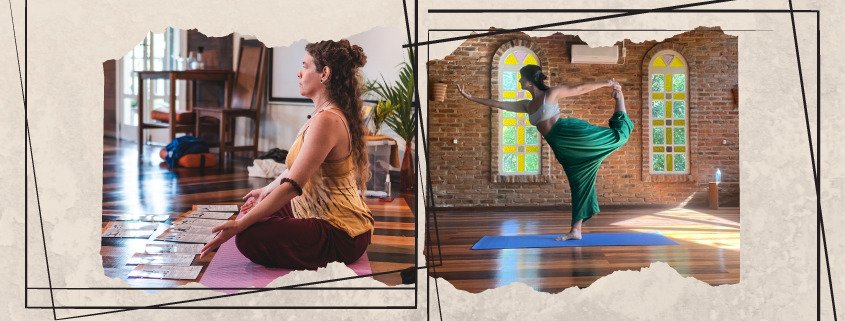Challenges and Tips for Freshly Graduated Yoga Teachers
The Universe of Yoga, its challenges and opportunities for those who seek to earn a living from this millennial philosophy
Starting a career as a yoga teacher can be challenging. From security to putting into practice everything you’ve learned, to financial sustainability. In this article, you will find tips and explore the trends of the universe of Yoga, in addition to meeting Bárbara and Amalia, two Yoga instructors who share a little bit about their journeys. Their perspectives are interesting because Amalia has been a Yoga teacher for 20 years while Barbara is a new graduate.
Challenges of new Yoga teachers
The Key to Yoga Teacher Self-Confidence: Practice and Everything Will Come
It is normal to feel insecure when teaching at first. Sometimes, all you need to do is remember that your background has given you the skills you need, and trust in yourself. At other times, it is necessary to have adequate support, your “bibles” where you can find reliable and accurate information whenever necessary.
But the main thing, according to Yoga teacher Amalia Iatarola Furtado, with 20 years of experience, is practice. “I had always had a very deep and regular Yoga practice when I became a teacher. In this respect, it was easy to start teaching, as I had a great base. When you are familiar with Yoga, you finish your training and the paths open up, things happen. You need to have a long-term personal practice”, says the instructor, who took her first Yoga training in 2003.
There are also those people who seek Yoga training to increase their overall knowledge of Yoga, and life calls them to become teachers. This was the case of Barbara Viegas da Silveira, who graduated in 2021. “When I did my training, my intention was not really to be an instructor. It turned out that this happened naturally, due to the directions my life took. I did not imagine myself teaching Yoga, but when I gave my first class, still in training, I realized how fulfilling it was to share my truth and perception of Yoga,” she says.
“My first classes were challenging. It was a mixture of fear, anxiety and nervousness, first because I was doing something new and second because I didn’t know if I would be able to reach people the way I wanted. I was afraid to make adjustments on the students, or to offer techniques beyond the level of the audience I had. I think that was my biggest challenge, knowing how to modify the class according to the needs of my group.”
“There was only one way for me to overcome my fears and challenges: giving lots of classes. I carefully observed all of the fears and emotions that came up while teaching, and took every opportunity to overcome the fears and strengthen the positive points of each class. Anyway, the main tip is: practice regularly, hone your skills and remember that experience is the best teacher. When you are in the position of a practitioner, you understand the student’s universe better.”
How to build a base of Yoga students?
Another challenge at the beginning of a Yoga teacher’s career is to consolidate their student base. Therefore, it is necessary to act on different fronts, such as marketing, partnerships and social media. “I believe that when we are living our Dharma, magic happens. In my life, everything happened through word of mouth, because when I graduated, social media on the internet didn’t exist yet. And while the times have changed dramatically, and social media is everywhere, I believe that word of mouth is still the strongest marketing”, jokes teacher Amália.
Tips: Invest time in personal marketing, promoting yourself on social media, handing out flyers, and even offering free classes to gain visibility. Take every opportunity to share your knowledge and show your passion for yoga. Remember that your students are your biggest business card. If they are happy and satisfied with their classes, they will certainly invite others to try it out.
Can being a Yoga teacher be financially sustainable?
The financial aspect can also be a challenge. It’s important to establish a fair pricing structure that reflects your experience level and the demands of the local market, considering offering class packages or discounts to attract more students. Teacher for 20 years, Amália believes that by aligning herself with the philosophy of Yoga, the paths open to financial prosperity. “I always generated income with Yoga, but when Yoga really became my life, not just as a profession, but as a path and journey, abundance came to me naturally.”
New yoga teacher Bárbara began her career in a completely different environment, post-COVID, with a completely different set of challenges. Almost from the beginning of her Yoga teacher career, she had to learn to give classes online, involving different fears and different challenges, but her persistence has paid ooo. “Today my income is divided into Yoga and other services. I feel that living 100% from Yoga is challenging, but it is very possible! It takes great dedication, as in everything in life, and online is a great tool for that, being able to connect with people who are in different places”, she says.
Material tips to prepare your Yoga class
Indicated by the instructors, we list here the best materials to prepare your Yoga class, gathering knowledge at the physical, subtle, mental, emotional and spiritual levels.
Yoga Toolbox for Teachers and Students
“I was blown away by the depth of the material. The Yoga Toolbox is a precious, valuable material, with an absurd amount of knowledge”, says Amália.

Asana and Mudra Card Decks
“In the beginning, I used decks a lot. I took the cards to class to help me remember the sequences. I began planning my classes using the Yoga Toolbox and then moved on to the decks. Today, I use the Toolbox a lot for specific questions, about variations, a muscle group or some benefit or contraindication of an asana”, says Barbara.





